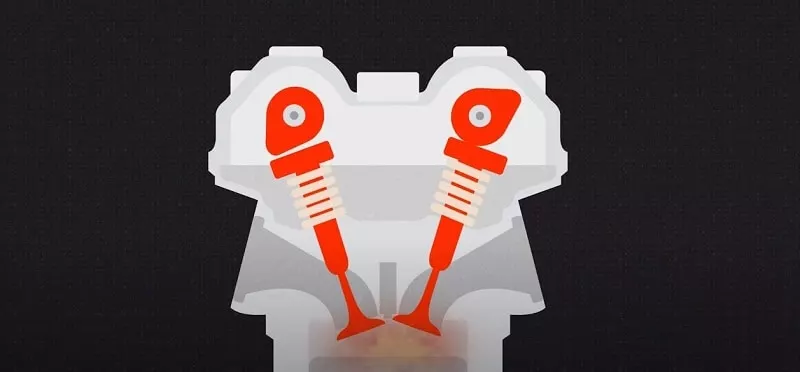Deprecated: mb_convert_encoding(): Handling HTML entities via mbstring is deprecated; use htmlspecialchars, htmlentities, or mb_encode_numericentity/mb_decode_numericentity instead in /home/u598013642/domains/motorcyclegear101.com/public_html/wp-content/themes/acabado/functions.php on line 2160
Deprecated: mb_convert_encoding(): Handling HTML entities via mbstring is deprecated; use htmlspecialchars, htmlentities, or mb_encode_numericentity/mb_decode_numericentity instead in /home/u598013642/domains/motorcyclegear101.com/public_html/wp-content/themes/acabado/functions.php on line 2160
Have you ever wondered about the red line on your bike’s tachometer? It’s that red shading in the upper reaches of the gauge that you’re not supposed to venture into. But why do engines have a rev ceiling, and why do some motorcycles have a low redline while others have a high red line?
Engines are kind of miraculous. I mean, there are so many parts spinning and reciprocating up and down between these cases, but it turns out there’s a limit to how fast things can move before bad stuff happens.
Reciprocating engine parts like the piston and connecting rod have mass and thus inertia and momentum, which means they will resist changes in speed and direction.
So the faster the engine revs, the heart of the piston will try and fly off the wrist pin, and the more violently the connecting rod is going to try and tear itself away from the crank.
And eventually, they will the parts will fatigue in the engine it’s going to turn to scrap.
It might be hard to imagine robust metal parts just giving up and breaking but consider this piston out of a CBR 600RR.
At redline, up near 15,000 RPM, it’s accelerating from a dead stop at the bottom of the stroke up to nearly 75 miles per hour midway through the stroke and then coming to a complete stop again at the top of the stroke. And it’s doing all of that in just four one-thousandths of a second.
That instantaneous acceleration creates a force of 1700 g’s on this little piston. This only weighs about four ounces in my hand when it’s changing direction at redline, which it’s doing 500 times per second.
It develops a load of roughly 450 pounds. That’s literally more than the entire CBR weighs.
So with that in mind, you can see how things might have a hard time staying together. So engines have a limit to how fast they can spin because, beyond a certain rpm, the effective weight of reciprocating parts will cause them to fatigue and break.
And even if you lighten and strengthen bottom end parts to cope with the rpm, there are other areas of the engine where inertia will rear its ugly head, namely the valve train.
In a four-stroke engine, valves in the cylinder head control the flow of fuel and air into the cylinder and the flow of exhaust gases out.

The valves are pushed open by the camshaft and closed by a spring. The spring exerts pressure to ensure that the valve always follows the cam’s motion and returns to a closed position.
If the engine is revved too high, however, the momentum of the valve chain components may be too strong for the spring to overcome, so the valve’s motion might not follow the cam’s motion as it’s closing.
This is called valve float, and it’s bad news because if the valve hangs open long enough, it may contact the piston as it’s rising in the cylinder, and you can imagine how that goes.
So valve float is another important reason why engines have redlines. Now there are engines like Ducati desmodromic motors that don’t rely on valve springs. Separate rocker arm forces the valve closed in a desmo engine, so valve float isn’t possible.
And two-stroke engines don’t even have valves to float, yet both desmo Ducatis and ringing two-strokes still have rev ceilings because their other reciprocating parts can’t escape the laws of physics.
Alright, so that’s why every engine, whether a two-stroke or a four-stroke, a desmo, or conventional valve spring, has a rev ceiling, but you might wonder why different bikes have different red lines?
A Harley Davidson Street Glide maxes out at just 5,500 rpm. Meanwhile, a Honda CBR 600RR spins to over 15,000 rpm. Once again, it has to do with inertia. Going back to the issue of valve float, there are significant differences in the design of these two engines.
The Honda is an overhead cam design that means the cams are up in the cylinder head and operate directly on the valves. It’s got fewer parts, so less mass and less inertia to contend with so the engine can spin faster before valve float is a concern.
On the other hand, Harley’s push rod valve train has more components. It’s got tappets, pushrods, and rocker arms in addition to the valves and springs. That’s a lot more mass to manage, limiting the speed the engine can turn before valve float occurs.
Then there’s piston speed which is proportional to piston stroke. The longer the stroke, the higher the maximum piston speed for a given engine rpm.
So at redline, this Harley street glides piston is maxing out at 64 miles per hour, not that much slower than the 75 miles per hour we saw for the CBR up at 15,000 rpm.
For this reason, sportbikes and other performance engines run a shorter stroke so they can turn higher rpm and make more horsepower.
There are other contributing factors to how fast an engine can spin, like intake and exhaust design or even how fast gasoline can burn in the cylinder. Still, by and large, the inertia of reciprocating parts determines the operating threshold for a given engine.
If all of this has you worrying about accidentally blowing up your engine because you gave it too much gas, don’t sweat it.
Most modern bikes have a rev limiter that will cut the fuel or the ignition in order to keep the engine revs at a safe speed, and most manufacturers bake in quite a bit of margin.
That being said, the rev limiter is there for your engine’s safety, not as a party trick at stoplights and bike nights. So go ahead and enjoy the revs your engine offers, which is everything up to the red line. You just don’t want to keep it spinning that high unnecessarily because it will wear your engine out faster.

